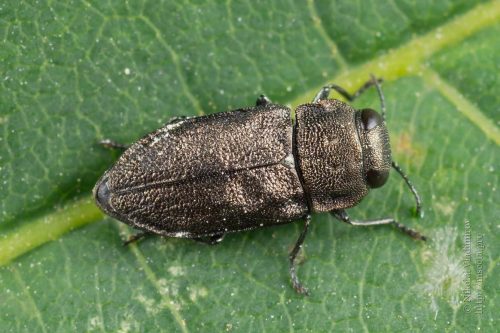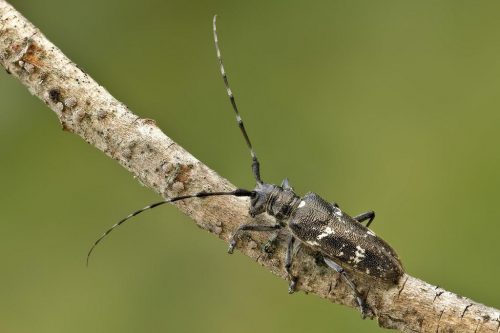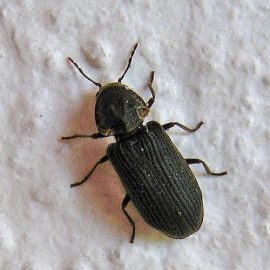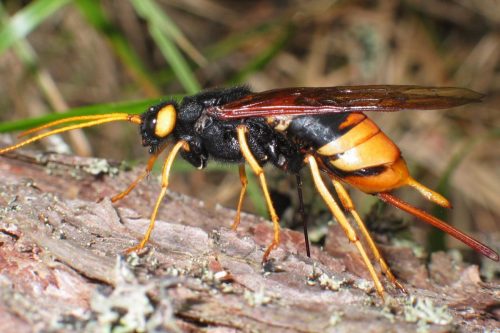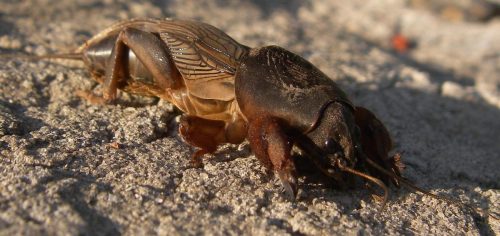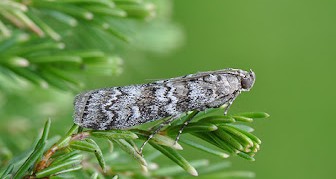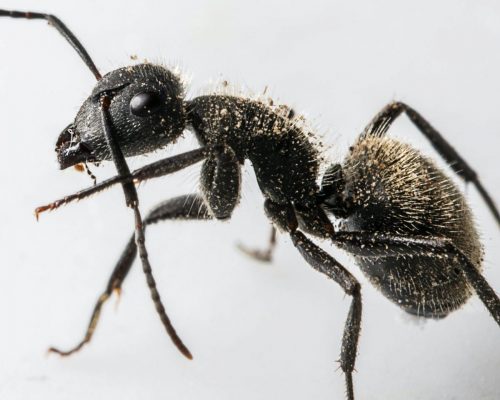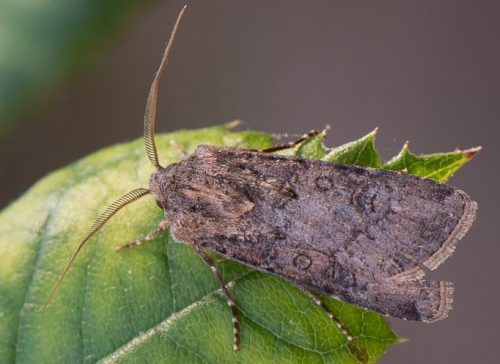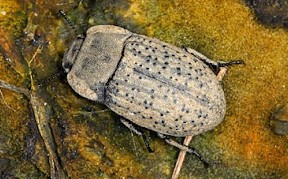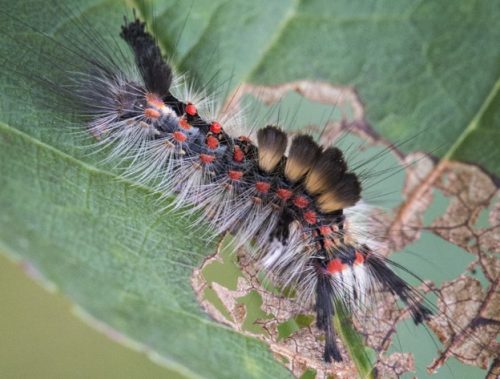Conifer pests: information and treatments
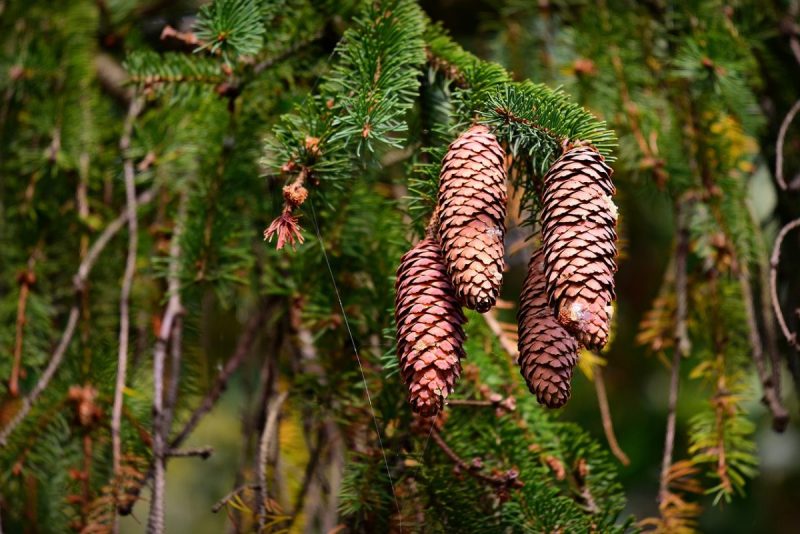
Conifer pests cause damage and occasionally permanently affect these plants in the urban landscape and rural forests to the point where they need to be cut. It is important to know what are the possible conifer pests, how to prevent them and how to treat against them.
ANTHAXIA quadripunctata – metallic wood-boring beetle
This species causes damage to conifers, especially to spruce, pine, larch, and other softwoods, preferring young trees with thin trunks. It develops a generation in two years. The adults feed on pollen, the flight is in June-July. It overwinters in the larval stage and the pupa is formed in the wood.
The larval galleries are narrow, sinuous, localized between bark and wood, imprinted on both sides (on the bark and on the wood). Larvae galleries are rectangular in section and are filled with sawdust. The attacked trees become weak, and over time they can dry out.
Control methods. The weakened trees are removed from the stand. The bark of the attacked trees is peeled and burned before the pupal stage.
Monochamus sartor
This conifer pest attacks mainly spruce and pine trees. It develops one or two generations a year. The adults feed on pollen, the flight is from May to September. It overwinters in the larval stage
The larvae feed under the bark, making galleries. Then they enter the wood through an oval hole and form the pupa inside. Adults exit the wood on a round (or elliptical) and large exit hole.
Control methods. It is recommended to detect the presence of pests in time, by observing the beetles during the flight. Also, the galleries and the specific entry-exit holes can be observed. Pheromone-baited and chemically treated trap logs are placed in the forest starting at the end of May. In summer, these are peeled off, before the larvae penetrate deep into the wood. The already damaged trees are removed from the stand before the flight of the beetles. The resulting wood is processed as soon as possible. During the flight, chemical treatments can be applied. In the case of individual trees with special importance, volatile substances can be injected into the entry holes.
Recommended products
-
You can find products on a different store
Change Store -
You can find products on a different store
Change Store -
You can find products on a different store
Change Store -
You can find products on a different store
Change Store -
You can find products on a different store
Change Store -
You can find products on a different store
Change Store -
You can find products on a different store
Change Store -
You can find products on a different store
Change Store -
You can find products on a different store
Change Store -
You can find products on a different store
Change Store -
You can find products on a different store
Change Store -
You can find products on a different store
Change Store -
You can find products on a different store
Change Store -
You can find products on a different store
Change Store -
You can find products on a different store
Change Store -
You can find products on a different store
Change Store -
You can find products on a different store
Change Store -
You can find products on a different store
Change Store -
You can find products on a different store
Change Store -
You can find products on a different store
Change Store -
You can find products on a different store
Change Store -
You can find products on a different store
Change Store -
You can find products on a different store
Change Store -
You can find products on a different store
Change Store
Anobium pertinax – woodworm
It is also known as the ‘house borer’. Damages are produced on spruce and pine wood, less often other on softwoods or sometimes even on hardwoods. It presents a multi-annual biological cycle, with the flight of adults from May to July-August. It overwinters in the larval, pupa, or adult stages.
The larvae feed on the dry wood, making irregular galleries, filled with fine sawdust. The attack is discovered by observing the flight holes (3 mm in diameter), by the sawdust that appears on the wood, and by the characteristic noise that male insects make during mating. Processed wood can be attacked inside without being noticed on the outside.
Control methods. To prevent woodworm attacks in forests, it is recommended to remove the wood before drying (eg. windthrown trees). For constructions, it is recommended to use dry wood material, treated with insecticides and insect repellents. In case of attacks, it is recommended to apply insecticides during the flight of the insects.
Recommended products
-
You can find products on a different store
Change Store -
You can find products on a different store
Change Store -
You can find products on a different store
Change Store -
You can find products on a different store
Change Store -
You can find products on a different store
Change Store -
You can find products on a different store
Change Store -
You can find products on a different store
Change Store -
You can find products on a different store
Change Store -
You can find products on a different store
Change Store -
You can find products on a different store
Change Store -
You can find products on a different store
Change Store -
You can find products on a different store
Change Store -
You can find products on a different store
Change Store -
You can find products on a different store
Change Store -
You can find products on a different store
Change Store -
You can find products on a different store
Change Store -
You can find products on a different store
Change Store -
You can find products on a different store
Change Store -
You can find products on a different store
Change Store -
You can find products on a different store
Change Store -
You can find products on a different store
Change Store -
You can find products on a different store
Change Store -
You can find products on a different store
Change Store -
You can find products on a different store
Change Store
Sirex gigas – giant wood wasp
Also known as the ‘banded horntail sawfly’ or the ‘pine wood wasp’, these conifer pests can produce damages on spruce, pine, fir, and larch wood. Logs placed in shade and moisture are frequently attacked. Woody material warehouses can also be affected. It has a generation every two years, with the flight extended until September. Adults feed on pollen and sap. Eggs are laid both in the wood of living trees and in felled wood or in stumps. The insect overwinters in the larval stage.
Damages are caused by larvae, which gnaw the galleries towards the central ring of the wood, after which they return to the outside and form a pupa. Adults make a round flight hole, with a diameter of 4-7 mm. The quality of the wood decreases after the attack. Also, in the created galleries, the development of other insects and fungi is favored.
Control methods. In order to reduce the insect population, it is recommended to remove the felled trees from the forests, because they represent favorable environments for the development of these conifer pests. Wood can be treated with insecticides. In case of heavy infestations, it is recommended to burn the attacked wood material.
Recommended products
-
You can find products on a different store
Change Store -
You can find products on a different store
Change Store -
You can find products on a different store
Change Store -
You can find products on a different store
Change Store -
You can find products on a different store
Change Store -
You can find products on a different store
Change Store -
You can find products on a different store
Change Store -
You can find products on a different store
Change Store -
You can find products on a different store
Change Store -
You can find products on a different store
Change Store -
You can find products on a different store
Change Store -
You can find products on a different store
Change Store -
You can find products on a different store
Change Store -
You can find products on a different store
Change Store -
You can find products on a different store
Change Store -
You can find products on a different store
Change Store -
You can find products on a different store
Change Store -
You can find products on a different store
Change Store -
You can find products on a different store
Change Store -
You can find products on a different store
Change Store -
You can find products on a different store
Change Store -
You can find products on a different store
Change Store -
You can find products on a different store
Change Store -
You can find products on a different store
Change Store
Melolontha melolontha – may bug
It is also known as the ‘common European cockchafer’ or the ‘white grub’ and it is a species with potential for mass multiplication. Damages caused by such conifer pests are produced to deciduous and softwoods in nurseries and plantations. It has a generation at 3-5 years, with the flight in May, sometimes in April. The larvae overwinter in the soil 2-3 times.
Adults feed on the leaves of plants and seedlings, sometimes producing strong defoliation. The larvae cause damage by feeding on the young roots.
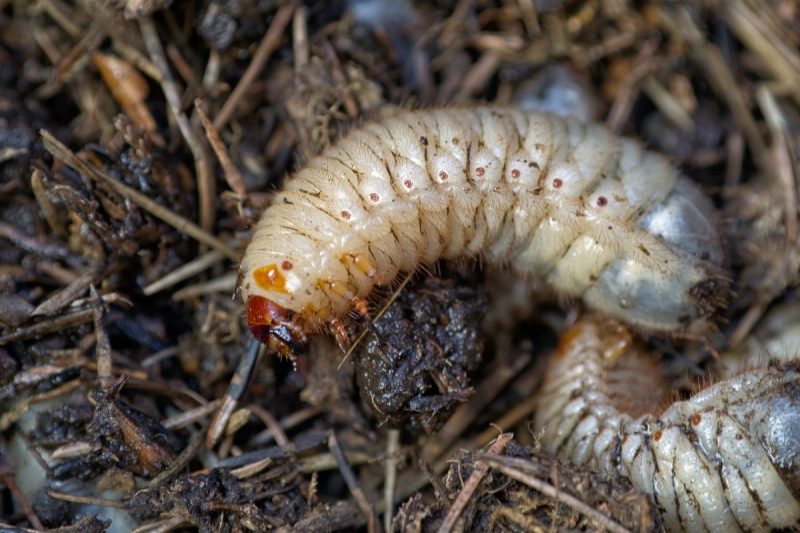
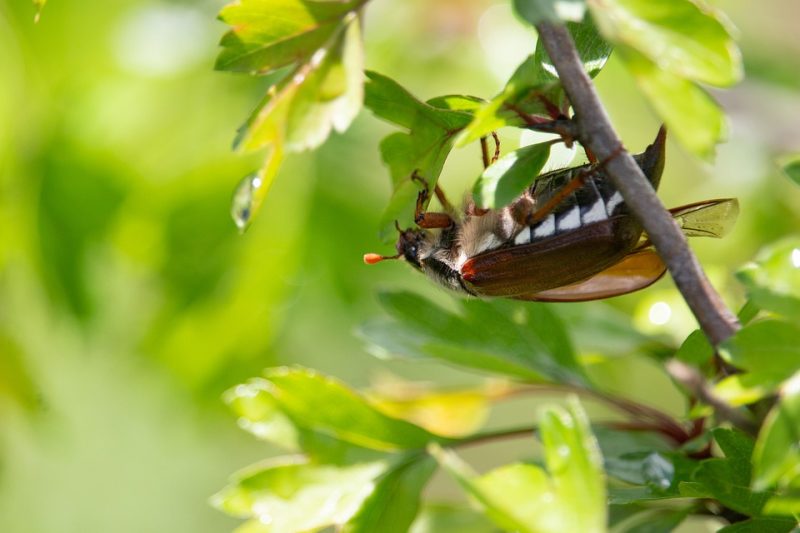
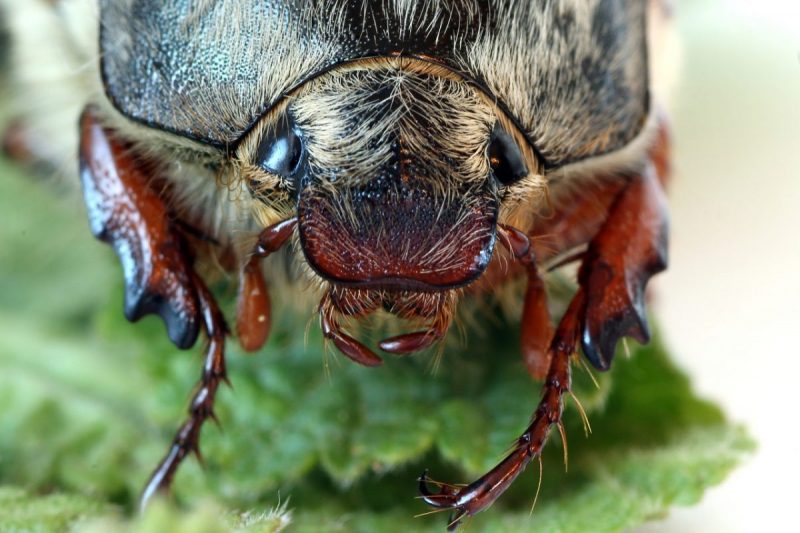
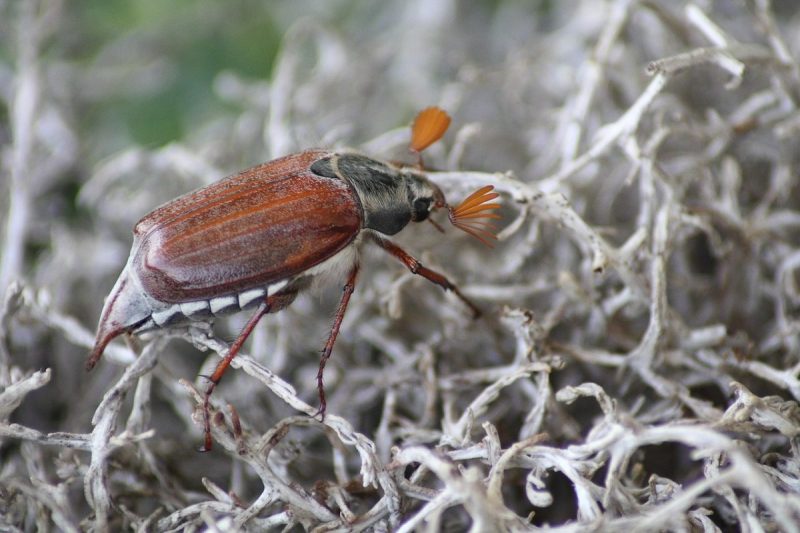
Control methods. It is recommended to detect the presence of larvae by soil surveys, dug in the ground in autumn. The larvae can also be observed during soil mobilization. Observations can also be made on adults during the flight, in the evening. Mechanical control consists of gathering and destroying larvae (from the soil) and beetles (attracted by light traps, during the evening). Another option is to shake, gather and destroy beetles from trees or bushes. Pheromones can be used for both monitoring and control. Contact insecticides can be applied to the soil during the flight so that egg-laying is prevented. In addition, it is recommended to treat the roots before planting and the seeds before sowing.
Recommended products
-
You can find products on a different store
Change Store -
You can find products on a different store
Change Store -
You can find products on a different store
Change Store -
You can find products on a different store
Change Store -
You can find products on a different store
Change Store -
You can find products on a different store
Change Store -
You can find products on a different store
Change Store -
You can find products on a different store
Change Store -
You can find products on a different store
Change Store -
You can find products on a different store
Change Store -
You can find products on a different store
Change Store -
You can find products on a different store
Change Store -
You can find products on a different store
Change Store -
You can find products on a different store
Change Store -
You can find products on a different store
Change Store -
You can find products on a different store
Change Store -
You can find products on a different store
Change Store -
You can find products on a different store
Change Store -
You can find products on a different store
Change Store -
You can find products on a different store
Change Store -
You can find products on a different store
Change Store -
You can find products on a different store
Change Store -
You can find products on a different store
Change Store -
You can find products on a different store
Change Store
Gryllotalpa gryllotalpa – mole cricket
It is also known as ‘jarr worm’ and it causes damage in plantations and nurseries, both on softwood and deciduous species. It usually has a generation every 2 years. In the first year, it overwinters in the larval stage, often in manure. In the second year, it overwinters in the young adult stage. During the flight, the males produce a specific sound, similar to that of crickets.
Damages are caused to the roots. Galleries made in the soil affect the soil structure and quality.
Control methods. It is important to detect the presence of the species in each development stage. The galleries and holes in the ground or the nests with eggs or larvae (located in the soil at a depth of 10-20 cm) can be observed easily. Mechanical control is performed by destroying nests and adults. Chemical control involves the use of insecticides.
Recommended products
-
You can find products on a different store
Change Store -
You can find products on a different store
Change Store -
You can find products on a different store
Change Store -
You can find products on a different store
Change Store -
You can find products on a different store
Change Store -
You can find products on a different store
Change Store -
You can find products on a different store
Change Store -
You can find products on a different store
Change Store -
You can find products on a different store
Change Store -
You can find products on a different store
Change Store -
You can find products on a different store
Change Store -
You can find products on a different store
Change Store -
You can find products on a different store
Change Store -
You can find products on a different store
Change Store -
You can find products on a different store
Change Store -
You can find products on a different store
Change Store -
You can find products on a different store
Change Store -
You can find products on a different store
Change Store -
You can find products on a different store
Change Store -
You can find products on a different store
Change Store -
You can find products on a different store
Change Store -
You can find products on a different store
Change Store -
You can find products on a different store
Change Store -
You can find products on a different store
Change Store
Dioryctria abietella – cone pyralid
It causes damage to spruce cones, fir, larch, pine, or other species, sometimes causing losses of up to 50% of seeds. It usually has one generation per year, but sometimes it can have 2 generations in one year. The flight takes place during the summer, in the evening. Wintering takes place in the caterpillar stage, in a cocoon, about 8 cm deep in the litter.
Damages are caused by larvae, which consume the seeds. The affected cone scales have the form of an anchor. The axis of the cone remains unharmed, but the cones deform and show insect excrements and silk threads. In the case of mass multiplication, the larvae attack the shoots of young trees, which can dry out after the attack.
Control methods. The gathering and destroying of the attacked cones is recommended. Chemical treatments can be applied during the flight. Contact insecticides can be applied at ground level before the larvae enter the soil for the winter period.
Recommended products
-
You can find products on a different store
Change Store -
You can find products on a different store
Change Store -
You can find products on a different store
Change Store -
You can find products on a different store
Change Store -
You can find products on a different store
Change Store -
You can find products on a different store
Change Store -
You can find products on a different store
Change Store -
You can find products on a different store
Change Store -
You can find products on a different store
Change Store -
You can find products on a different store
Change Store -
You can find products on a different store
Change Store -
You can find products on a different store
Change Store -
You can find products on a different store
Change Store -
You can find products on a different store
Change Store -
You can find products on a different store
Change Store -
You can find products on a different store
Change Store -
You can find products on a different store
Change Store -
You can find products on a different store
Change Store -
You can find products on a different store
Change Store -
You can find products on a different store
Change Store -
You can find products on a different store
Change Store -
You can find products on a different store
Change Store -
You can find products on a different store
Change Store -
You can find products on a different store
Change Store
Camponotus herculeanus – black carpenter ant conifer pests
Most ants are considered useful insects, predators of other harmful insects. However, the great black ant is a harmful species, causing significant damage to conifers. It has one generation per year.
They mainly cause damage to trees with various wounds or holes that already exist, entering through them and making galleries inside the trunk. They can also attack healthy trees. The galleries can reach a height of 10 m in the trunk and aim to build nests.
Control methods. It is recommended to prevent mass multiplication by extracting trees that have wounds, diseases, or holes of various kinds. Infested trees and stumps are preferably removed in winter, then burned.
Agrotis segetum – turnip moth conifer pests
It is also known as ‘black cutworm’, ‘common cutworm’, or ‘dart moth’. It is a specific pest in nurseries and plantations, which attacks both deciduous species and conifers. The turnip moth has two generations a year, with butterflies flying from May to August, in the evening. It overwinters in the soil, in the caterpillar stage.
Caterpillars consume germinated seeds, thin roots, and young leaves. Young stems can also be attacked, especially at ground level.
Control methods. Mechanical control is performed by gathering and destroying caterpillars once the soil is mobilized or when the withered seedlings are removed. For the adult stage, it is recommended to use sticky panels together with light sources during the night. Pheromone traps or contact insecticides can also be used during the flight.
Recommended products
-
You can find products on a different store
Change Store -
You can find products on a different store
Change Store -
You can find products on a different store
Change Store -
You can find products on a different store
Change Store -
You can find products on a different store
Change Store -
You can find products on a different store
Change Store -
You can find products on a different store
Change Store -
You can find products on a different store
Change Store -
You can find products on a different store
Change Store -
You can find products on a different store
Change Store -
You can find products on a different store
Change Store -
You can find products on a different store
Change Store -
You can find products on a different store
Change Store -
You can find products on a different store
Change Store -
You can find products on a different store
Change Store -
You can find products on a different store
Change Store -
You can find products on a different store
Change Store -
You can find products on a different store
Change Store -
You can find products on a different store
Change Store -
You can find products on a different store
Change Store -
You can find products on a different store
Change Store -
You can find products on a different store
Change Store -
You can find products on a different store
Change Store -
You can find products on a different store
Change Store
Opatrum sabulosum
Such conifer pests can cause significant damage to hardwood and softwood nurseries and plantations. It develops one generation per year, and overwinters in the adult stage, in the soil. The beetles attack the seeds and seedlings (at ground level) in the spring. The larvae gnaw the roots and the germinated seeds.
Control methods. Mechanical control can be performed by gathering and destroying larvae and beetles. The soil can be treated with contact insecticides.
Recommended products
-
You can find products on a different store
Change Store -
You can find products on a different store
Change Store -
You can find products on a different store
Change Store -
You can find products on a different store
Change Store -
You can find products on a different store
Change Store -
You can find products on a different store
Change Store -
You can find products on a different store
Change Store -
You can find products on a different store
Change Store -
You can find products on a different store
Change Store -
You can find products on a different store
Change Store -
You can find products on a different store
Change Store -
You can find products on a different store
Change Store -
You can find products on a different store
Change Store -
You can find products on a different store
Change Store -
You can find products on a different store
Change Store -
You can find products on a different store
Change Store -
You can find products on a different store
Change Store -
You can find products on a different store
Change Store -
You can find products on a different store
Change Store -
You can find products on a different store
Change Store -
You can find products on a different store
Change Store -
You can find products on a different store
Change Store -
You can find products on a different store
Change Store -
You can find products on a different store
Change Store
Orgyia antiqua – rusty tussock moth
It is also known as the ‘vapourer moth’, the ‘antique tussock moth’, or the ‘European tussock moth’. Damages are produced both to coniferous and deciduous species, especially to older trees. It has one or two generations per year. The flight is in June-July (and in September, if there are two generations per year). It overwinters in the egg stage, in the cracks of the bark.
Caterpillars cause damages by defoliation. They prefer the lighted parts of the crown.
Control methods. Visual observations can be carried out on each stage of development, especially the egg stage, during the winter. In the case of mass multiplications, chemical treatments can be applied, especially in the caterpillar stage.
Recommended products
-
You can find products on a different store
Change Store -
You can find products on a different store
Change Store -
You can find products on a different store
Change Store -
You can find products on a different store
Change Store -
You can find products on a different store
Change Store -
You can find products on a different store
Change Store -
You can find products on a different store
Change Store -
You can find products on a different store
Change Store -
You can find products on a different store
Change Store -
You can find products on a different store
Change Store -
You can find products on a different store
Change Store -
You can find products on a different store
Change Store -
You can find products on a different store
Change Store -
You can find products on a different store
Change Store -
You can find products on a different store
Change Store -
You can find products on a different store
Change Store -
You can find products on a different store
Change Store -
You can find products on a different store
Change Store -
You can find products on a different store
Change Store -
You can find products on a different store
Change Store -
You can find products on a different store
Change Store -
You can find products on a different store
Change Store -
You can find products on a different store
Change Store -
You can find products on a different store
Change Store














































































































































































































































































































































































































































